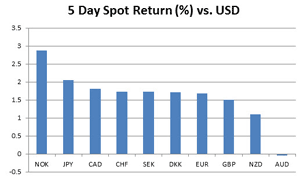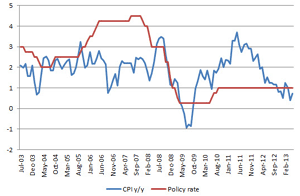Technician Eric Viloria of Forex.com highlights the events and indicators likely to shape the forex markets this week.
FX Return Analysis
The USD looks set to end the week markedly lower against most of its G10 counterparts with the exception of the AUD. The greenback took a sharp turn lower on Wednesday after being dealt a one-two punch from the release of the June FOMC minutes, which were shortly followed by dovish comments from Bernanke. Norway’s krone is currently the top performer against the USD and the JPY is next. The Japanese yen firmed after the International Monetary Fund (IMF) upgraded its outlook for 2013 GDP forecast in Japan to 2.0% and as the Bank of Japan indicated no change in policy at its two-day meeting. However, as global yields move higher relative to Japan, Japanese investors may commit funds overseas resulting in an outflow of JPY.
Figure 1: G10 FX Spot Returns vs. the US Dollar
Source: Bloomberg
Overall moves appear to be corrective in our view and we think that the longer-term trends of USD strength and JPY, GBP, AUD weakness will resume once the dust settles. In fact, despite a short-lived rebound, the AUD has remained under pressure last week and is currently the weakest performing G10 currency against the USD year-to-date. A slew of economic data will be released out of China this week including 2Q GDP figures. China’s Finance Minister Lou noted that 1H growth will be slower than the 7.7% seen in 1Q but added that it may be “not too far from” that level. Markets have anticipated 2Q GDP to slow to 7.5%. June retail sales, fixed assets investments, and industrial production data will also be released out of China on today. The data is likely to add further evidence to the slowdown in China, which has negative implications on the broader outlook for global growth as China is the world’s second largest economy.
The EUR is stronger against the buck but mixed against the rest of the majors as European Central Bank officials give mixed signals to the markets. Executive Board member Asmussen’s comments that forward guidance goes “beyond 12 months” was swiftly clarified by the ECB as the bank stated that his comments were not intended to give a specific period of forward guidance. ECB’s Coeure also spoke this past week and said that LTRO and negative rates remain part of the bank’s toolbox. We think that the increasingly dovish tone from the ECB is likely to weigh on the outlook for the common currency moving forward and any further data deterioration will likely exacerbate moves to the downside.
How Long Will the USD Correction Last?
We believe that the current weakness in the USD is not likely to persist for an extended period as markets digest central bankers’ rhetoric. Though comments from Fed Chairman Bernanke on Wednesday were dovish as he indicated “highly accommodative policy in the foreseeable future”, the message has not changed from the June meeting. Fed officials have been trying to separate QE tapering from rate hikes and emphasizing that tapering is not tightening as we have previously indicated.
NEXT PAGE: What’s Next for the Canadian Dollar?
|pagebreak|We think that the factor driving USD strength after the current bout of weakness turns will be the relative direction of monetary policy. For instance, the Fed, ECB, BOE, and BOJ are all accommodative for now. However, the Fed is headed toward providing less accommodation while the monetary policies in Europe, UK, and Japan may become more accommodative. We think that these differences will be reflected in yields and exchange rates as policy becomes increasingly significant.
As such, there is scope for the US dollar to rebound as markets adjust and central bank officials clarify their respective stances. As we have seen recently, the ECB and BOE have sought to distance themselves from Fed policy as the rise in US yields has spilled over into Europe. Bernanke will speak again next week in his semi-annual testimony before Congress. He will deliver his policy report to the House on Wednesday and then to the Senate on Thursday. We expect his comments to be consistent with recent statements as he reiterates ongoing accommodation even if the pace of asset purchases slows. If and when the Fed begins to taper, its balance sheet will still be expanding although at a slower pace. Tightening will not occur until the balance sheet shrinks.
Technically, the dollar index may find support around the 100-day simple moving average (SMA) which is just above 82.50. If it falls below that level, the 200-day SMA will be the next pivot to the downside and it comes in around 81.35 currently. Key resistance is around the highs of last week (which are also 3-year highs) around 84.75.
BOC First Policy Meeting Under Poloz
The Bank of Canada (BOC) will meet on Wednesday, July 17, to announce policy and the meeting will be the first for newly installed Governor Stephen Poloz. The BOC has kept rates on hold at 1% since September 2010 and we think that rates will remain at 1% next week.
More importantly will be the tone of the statement. The BOC has noted for some time that “some modest withdrawal will likely be required” although “the considerable monetary policy stimulus will likely remain appropriate for a period of time.” Recent economic data has shown deterioration in activity with a decline in retail sales and slowing inflation. Inflation as measured by the change in headline consumer price index (CPI) is running at 0.7% y/y which is below the BOC’s target range of 1%-3%. Therefore there is risk for the statement to drop its relatively hawkish rhetoric and shift to even more of a neutral stance.
Figure 2: Canada’s yearly CPI is currently at 0.7% – below the BOC’s target range
Source: Bloomberg, FOREX.com
A shift in the tone of the statement could weigh on the Canadian dollar, which recently hit its lowest level against the USD since 2011. Therefore, the current pullback in USD/CAD may not be sustained if the pair rebounds to continue its upward trend. This is also in line with our constructive USD outlook. So will Poloz come in with a bang at his first meeting like his predecessor Mark Carney did over at the Bank of England?
By Eric Viloria, CMT, Chief Currency Strategist, Forex.com























